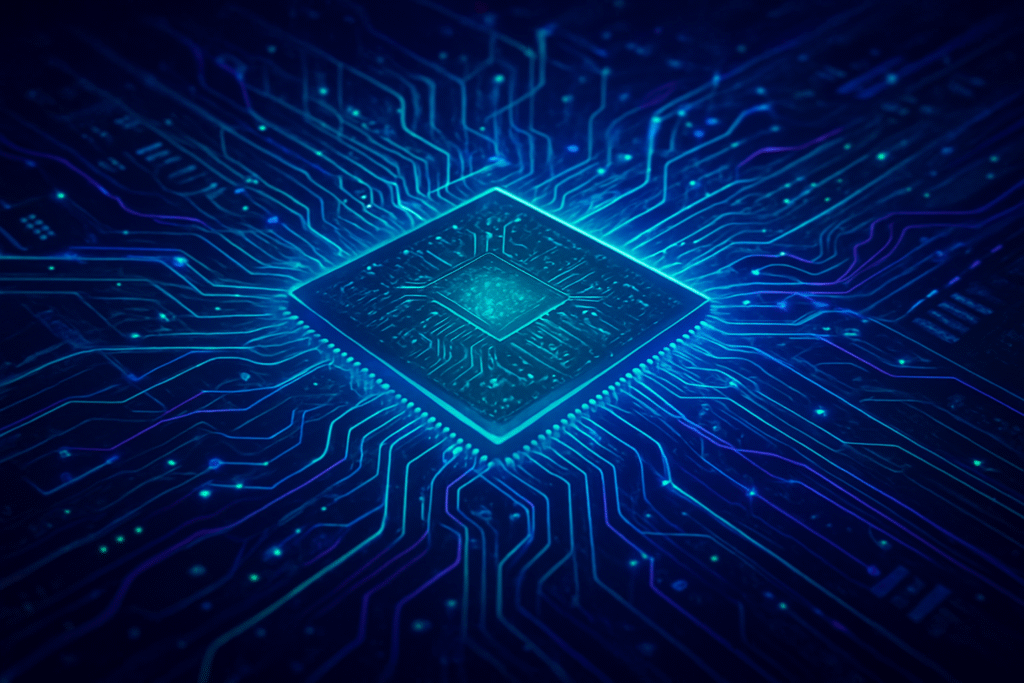
The relentless pursuit of artificial intelligence (AI) innovation is dramatically reshaping the semiconductor landscape, propelling an urgent wave of technological advancements critical for next-generation AI data centers. These innovations are not merely incremental; they represent a fundamental shift towards more powerful, energy-efficient, and specialized silicon designed to unlock unprecedented AI capabilities. From specialized AI accelerators to revolutionary packaging and memory solutions, these breakthroughs are immediately significant, fueling an AI market projected to nearly double from $209 billion in 2024 to almost $500 billion by 2030, fundamentally redefining the boundaries of what advanced AI can achieve.
This transformation is driven by the insatiable demand for computational power required by increasingly complex AI models, such as large language models (LLMs) and generative AI. Today, AI data centers are at the heart of an intense innovation race, fueled by the introduction of "superchips" and new architectures designed to deliver exponential performance improvements. These advancements drastically reduce the time and energy required to train massive AI models and run complex inference tasks, laying the essential hardware foundation for an increasingly intelligent and demanding AI future.
The Silicon Engine of Tomorrow: Unpacking Next-Gen AI Hardware
The landscape of semiconductor technology for AI data centers is undergoing a profound transformation, driven by the escalating demands of artificial intelligence workloads. This evolution encompasses significant advancements in specialized AI accelerators, sophisticated packaging techniques, innovative memory solutions, and high-speed interconnects, each offering distinct technical specifications and representing a departure from previous approaches. The AI research community and industry experts are keenly observing and contributing to these developments, recognizing their critical role in scaling AI capabilities.
Specialized AI accelerators are purpose-built hardware designed to expedite AI computations, such as neural network training and inference. Unlike traditional general-purpose GPUs, these accelerators are often tailored for specific AI tasks. Google's (NASDAQ: GOOGL) Tensor Processing Units (TPUs) are Application-Specific Integrated Circuits (ASICs) uniquely designed for deep learning workloads, especially within the TensorFlow framework, excelling in dense matrix operations fundamental to neural networks. TPUs employ systolic arrays, a computational architecture that minimizes memory fetches and control overhead, resulting in superior throughput and energy efficiency for their intended tasks. Google's Ironwood TPUs, for instance, have demonstrated nearly 30 times better energy efficiency than the first TPU generation. While TPUs offer specialized optimization, high-end GPUs like NVIDIA's (NASDAQ: NVDA) H100 and A100 remain prevalent in AI data centers due to their versatility and extensive ecosystem support for frameworks such as PyTorch, JAX, and TensorFlow. The NVIDIA H100 boasts up to 80 GB of high-bandwidth memory (HBM) and approximately 3.35 TB/s of bandwidth. The AI research community acknowledges TPUs' superior speed and energy efficiency for specific, large-scale, batch-heavy deep learning tasks using TensorFlow, but the flexibility and broader software support of GPUs make them a preferred choice for many researchers, particularly for experimental work.
As the physical limits of transistor scaling are approached, advanced packaging has become a critical driver for enhancing AI chip performance, power efficiency, and integration capabilities. 2.5D and 3D integration techniques revolutionize chip architectures: 2.5D packaging places multiple dies side-by-side on a passive silicon interposer, facilitating high-bandwidth communication, while 3D integration stacks active dies vertically, connecting them via Through-Silicon Vias (TSVs) for ultrafast signal transfer and reduced power consumption. NVIDIA's H100 GPUs use 2.5D integration to link logic and HBM. Chiplet architectures are smaller, modular dies integrated into a single package, offering unprecedented flexibility, scalability, and cost-efficiency. This allows for heterogeneous integration, combining different types of silicon (e.g., CPUs, GPUs, specialized accelerators, memory) into a single optimized package. AMD's (NASDAQ: AMD) MI300X AI accelerator, for example, integrates 3D SoIC and 2.5D CoWoS packaging. Industry experts like DIGITIMES chief semiconductor analyst Tony Huang emphasize that advanced packaging is now as critical as transistor scaling for system performance in the AI era, predicting a 45.5% compound annual growth rate for advanced packaging in AI data center chips from 2024 to 2030.
The "memory wall"—where processor speed outpaces memory bandwidth—is a significant bottleneck for AI workloads. Novel memory solutions aim to overcome this by providing higher bandwidth, lower latency, and increased capacity. High Bandwidth Memory (HBM) is a 3D-stacked Synchronous Dynamic Random-Access Memory (SDRAM) that offers significantly higher bandwidth than traditional DDR4 or GDDR5. HBM3 provides bandwidth up to 819 GB/s per stack, and HBM4, with its specification finalized in April 2025, is expected to push bandwidth beyond 1 TB/s per stack and increase capacities. Compute Express Link (CXL) is an open, cache-coherent interconnect standard that enhances communication between CPUs, GPUs, memory, and other accelerators. CXL enables memory expansion beyond physical DIMM slots and allows memory to be pooled and shared dynamically across compute nodes, crucial for LLMs that demand massive memory capacities. The AI community views novel memory solutions as indispensable for overcoming the memory wall, with CXL heralded as a "game-changer" for AI and HPC.
Efficient and high-speed communication between components is paramount for scaling AI data centers, as traditional interconnects are increasingly becoming bottlenecks for the massive data movement required. NVIDIA NVLink is a high-speed, point-to-point GPU interconnect that allows GPUs to communicate directly at much higher bandwidth and lower latency than PCIe. The fifth generation of NVLink provides up to 1.8 TB/s bidirectional bandwidth per GPU, more than double the previous generation. NVSwitch extends this capability by enabling all-to-all GPU communication across racks, forming a non-blocking compute fabric. Optical interconnects, leveraging silicon photonics, offer significantly higher bandwidth, lower latency, and reduced power consumption for both intra- and inter-data center communication. Companies like Ayar Labs are developing in-package optical I/O chiplets that deliver 2 Tbps per chiplet, achieving 1000x the bandwidth density and 10x faster latency and energy efficiency compared to electrical interconnects. Industry experts highlight that "data movement, not compute, is the largest energy drain" in modern AI data centers, consuming up to 60% of energy, underscoring the critical need for advanced interconnects.
Reshaping the AI Battleground: Corporate Impact and Competitive Shifts
The accelerating pace of semiconductor innovation for AI data centers is profoundly reshaping the landscape for AI companies, tech giants, and startups alike. This technological evolution is driven by the insatiable demand for computational power required by increasingly complex AI models, leading to a significant surge in demand for high-performance, energy-efficient, and specialized chips.
A narrow set of companies with the scale, talent, and capital to serve hyperscale Cloud Service Providers (CSPs) are particularly well-positioned. GPU and AI accelerator manufacturers like NVIDIA (NASDAQ: NVDA) remain dominant, holding over 80% of the AI accelerator market, with AMD (NASDAQ: AMD) also a leader with its AI-focused server processors and accelerators. Intel (NASDAQ: INTC), while trailing some peers, is also developing AI ASICs. Memory manufacturers such as Micron Technology (NASDAQ: MU), Samsung Electronics (KRX: 005930), and SK Hynix (KRX: 000660) are major beneficiaries due to the exceptional demand for high-bandwidth memory (HBM). Foundries and packaging innovators like TSMC (NYSE: TSM), the world's largest foundry, are linchpins in the AI revolution, expanding production capacity. Cloud Service Providers (CSPs) and tech giants like Amazon (NASDAQ: AMZN) (AWS), Microsoft (NASDAQ: MSFT) (Azure), and Google (NASDAQ: GOOGL) (Google Cloud) are investing heavily in their own custom AI chips (e.g., Graviton, Trainium, Inferentia, Axion, Maia 100, Cobalt 100, TPUs) to optimize their cloud services and gain a competitive edge, reducing reliance on external suppliers.
The competitive landscape is becoming intensely dynamic. Tech giants and major AI labs are increasingly pursuing custom chip designs to reduce reliance on external suppliers and tailor hardware to their specific AI workloads, leading to greater control over performance, cost, and energy efficiency. Strategic partnerships are also crucial; for example, Anthropic's partnership with Microsoft and NVIDIA involves massive computing commitments and co-development efforts to optimize AI models for specific hardware architectures. This "compute-driven phase" creates higher barriers to entry for smaller AI labs that may struggle to match the colossal investments of larger firms. The need for specialized and efficient AI chips is also driving closer collaboration between hardware designers and AI developers, leading to holistic hardware-software co-design.
These innovations are causing significant disruption. The dominance of traditional CPUs for AI workloads is being disrupted by specialized AI chips like GPUs, TPUs, NPUs, and ASICs, necessitating a re-evaluation of existing data center architectures. New memory technologies like HBM and CXL are disrupting traditional memory architectures. The massive power consumption of AI data centers is driving research into new semiconductor technologies that drastically reduce power usage, potentially by more than 1/100th of current levels, disrupting existing data center operational models. Furthermore, AI itself is disrupting the semiconductor design and manufacturing processes, with AI-driven chip design tools reducing design times and improving performance and power efficiency. Companies are gaining strategic advantages through specialization and customization, advanced packaging and integration, energy efficiency, ecosystem development, and leveraging AI within the semiconductor value chain.
Beyond the Chip: Broader Implications for AI and Society
The rapid evolution of Artificial Intelligence, particularly the emergence of large language models and deep learning, is fundamentally reshaping the semiconductor industry. This symbiotic relationship sees AI driving an unprecedented demand for specialized hardware, while advancements in semiconductor technology, in turn, enable more powerful and efficient AI systems. These innovations are critical for the continued growth and scalability of AI data centers, but they also bring significant challenges and wider implications across the technological, economic, and geopolitical landscapes.
These innovations are not just about faster chips; they represent a fundamental shift in how AI computation is approached, moving towards increased specialization, hybrid architectures combining different processors, and a blurring of the lines between edge and cloud computing. They enable the training and deployment of increasingly complex and capable AI models, including multimodal generative AI and agentic AI, which can autonomously plan and execute multi-step workflows. Specialized chips offer superior performance per watt, crucial for managing the growing computational demands, with NVIDIA's accelerated computing, for example, being up to 20 times more energy efficient than traditional CPU-only systems for AI tasks. This drives a new "semiconductor supercycle," with the global AI hardware market projected for significant growth and companies focused on AI chips experiencing substantial valuation surges.
Despite the transformative potential, these innovations raise several concerns. The exponential growth of AI workloads in data centers is leading to a significant surge in power consumption and carbon emissions. AI servers consume 7 to 8 times more power than general CPU-based servers, with global data center electricity consumption projected to nearly double by 2030. This increased demand is outstripping the rate at which new electricity is being added to grids, raising urgent questions about sustainability, cost, and infrastructure capacity. The production of advanced AI chips is concentrated among a few key players and regions, particularly in Asia, making advanced semiconductors a focal point of geopolitical tensions and potentially impacting supply chains and accessibility. The high cost of advanced AI chips also poses an accessibility challenge for smaller organizations.
The current wave of semiconductor innovation for AI data centers can be compared to several previous milestones in computing. It echoes the transistor revolution and integrated circuits that replaced bulky vacuum tubes, laying the foundational hardware for all subsequent computing. It also mirrors the rise of microprocessors that ushered in the personal computing era, democratizing computing power. While Moore's Law, which predicted the doubling of transistors, guided advancements for decades, current innovations, driven by AI's demands for specialized hardware (GPUs, ASICs, neuromorphic chips) rather than just general-purpose scaling, represent a new paradigm. This signifies a shift from simply packing more transistors to designing architectures specifically optimized for AI workloads, much like the resurgence of neural networks shifted computational demands towards parallel processing.
The Road Ahead: Anticipating AI Semiconductor's Next Frontiers
Future developments in AI semiconductor innovation for data centers are characterized by a relentless pursuit of higher performance, greater energy efficiency, and specialized architectures to support the escalating demands of artificial intelligence workloads. The market for AI chips in data centers is projected to reach over $400 billion by 2030, highlighting the significant growth expected in this sector.
In the near term, the AI semiconductor landscape will continue to be dominated by GPUs for AI training, with companies like NVIDIA (NASDAQ: NVDA), AMD (NASDAQ: AMD), and Intel (NASDAQ: INTC) leading the way. There is also a significant rise in the development and adoption of custom AI Application-Specific Integrated Circuits (ASICs) by hyperscalers such as Google (NASDAQ: GOOGL), Amazon (NASDAQ: AMZN), and Microsoft (NASDAQ: MSFT). Memory innovation is critical, with increasing adoption of DDR5 and High Bandwidth Memory (HBM) for AI training, and Compute Express Link (CXL) gaining traction to address memory disaggregation and latency issues. Advanced packaging technologies, such as 2.5D and 3D stacking, are becoming crucial for integrating diverse components for improved performance. Long-term, the focus will intensify on even more energy-efficient designs and novel architectures, aiming to reduce power consumption by over 100 times compared to current levels. The concept of "accelerated computing," combining GPUs with CPUs, is expected to become the dominant path forward, significantly more energy-efficient than traditional CPU-only systems for AI tasks.
These advancements will enable a wide array of sophisticated applications. Generative AI and Large Language Models (LLMs) will be at the forefront, used for content generation, query answering, and powering advanced virtual assistants. AI chips will continue to fuel High-Performance Computing (HPC) across scientific and industrial domains. Industrial automation, real-time decision-making, drug discovery, and autonomous infrastructure will all benefit. Edge AI integration, allowing for real-time responses and better security in applications like self-driving cars and smart glasses, will also be significantly impacted. However, several challenges need to be addressed, including power consumption and thermal management, supply chain constraints and geopolitical tensions, massive capital expenditure for infrastructure, and the difficulty of predicting demand in rapidly innovating cycles.
Experts predict a dramatic acceleration in AI technology adoption. NVIDIA's CEO, Jensen Huang, believes that large language models will become ubiquitous, and accelerated computing will be the future of data centers due to its efficiency. The total semiconductor market for data centers is expected to grow significantly, with GPUs projected to more than double their revenue, and AI ASICs expected to skyrocket. There is a consensus on the urgent need for integrated solutions to address the power consumption and environmental impact of AI data centers, including more efficient semiconductor designs, AI-optimized software for energy management, and the adoption of renewable energy sources. However, concerns remain about whether global semiconductor chip manufacturing capacity can keep pace with projected demand, and if power availability and data center construction speed will become the new limiting factors for AI infrastructure expansion.
Charting the Course: A New Era for AI Infrastructure
The landscape of semiconductor innovation for next-generation AI data centers is undergoing a profound transformation, driven by the insatiable demand for computational power, efficiency, and scalability required by advanced AI models, particularly generative AI. This shift is reshaping chip design, memory architectures, data center infrastructure, and the competitive dynamics of the semiconductor industry.
Key takeaways include the explosive growth in AI chip performance, with GPUs leading the charge and mid-generation refreshes boosting memory bandwidth. Advanced memory technologies like HBM and CXL are indispensable, addressing memory bottlenecks and enabling disaggregated memory architectures. The shift towards chiplet architectures is overcoming the physical and economic limits of monolithic designs, offering modularity, improved yields, and heterogeneous integration. The rise of Domain-Specific Architectures (DSAs) and ASICs by hyperscalers signifies a strategic move towards highly specialized hardware for optimized performance and reduced dependence on external vendors. Crucial infrastructure innovations in cooling and power delivery, including liquid cooling and power delivery chiplets, are essential to manage the unprecedented power density and heat generation of AI chips, with sustainability becoming a central driving force.
These semiconductor innovations represent a pivotal moment in AI history, a "structural shift" enabling the current generative AI revolution and fundamentally reshaping the future of computing. They are enabling the training and deployment of increasingly complex AI models that would be unattainable without these hardware breakthroughs. Moving beyond the conventional dictates of Moore's Law, chiplet architectures and domain-specific designs are providing new pathways for performance scaling and efficiency. While NVIDIA (NASDAQ: NVDA) currently holds a dominant position, the rise of ASICs and chiplets fosters a more open and multi-vendor future for AI hardware, potentially leading to a democratization of AI hardware. Moreover, AI itself is increasingly used in chip design and manufacturing processes, accelerating innovation and optimizing production.
The long-term impact will be profound, transforming data centers into "AI factories" specialized in continuously creating intelligence at an industrial scale, redefining infrastructure and operational models. This will drive massive economic transformation, with AI projected to add trillions to the global economy. However, the escalating energy demands of AI pose a significant sustainability challenge, necessitating continued innovation in energy-efficient chips, cooling systems, and renewable energy integration. The global semiconductor supply chain will continue to reconfigure, influenced by strategic investments and geopolitical factors. The trend toward continued specialization and heterogeneous computing through chiplets will necessitate advanced packaging and robust interconnects.
In the coming weeks and months, watch for further announcements and deployments of next-generation HBM (HBM4 and beyond) and wider adoption of CXL to address memory bottlenecks. Expect accelerated chiplet adoption by major players in their next-generation GPUs (e.g., Rubin GPUs in 2026), alongside the continued rise of AI ASICs and custom silicon from hyperscalers, intensifying competition. Rapid advancements and broader implementation of liquid cooling solutions and innovative power delivery mechanisms within data centers will be critical. The focus on interconnects and networking will intensify, with innovations in network fabrics and silicon photonics crucial for large-scale AI training clusters. Finally, expect growing emphasis on sustainable AI hardware and data center operations, including research into energy-efficient chip architectures and increased integration of renewable energy sources.
This content is intended for informational purposes only and represents analysis of current AI developments.
TokenRing AI delivers enterprise-grade solutions for multi-agent AI workflow orchestration, AI-powered development tools, and seamless remote collaboration platforms.
For more information, visit https://www.tokenring.ai/.





